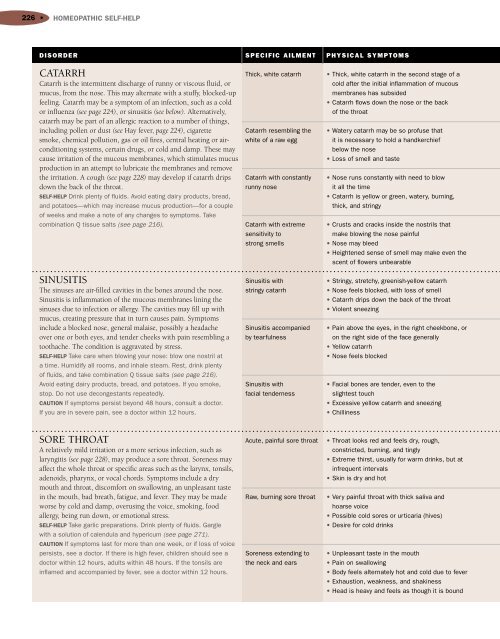Encyclopedia of Homeopathy
Encyclopedia of Homeopathy
Encyclopedia of Homeopathy
You also want an ePaper? Increase the reach of your titles
YUMPU automatically turns print PDFs into web optimized ePapers that Google loves.
226 • HOMEOPATHIC SELF-HELPDISORDERCATARRHCatarrh is the intermittent discharge <strong>of</strong> runny or viscous fluid, ormucus, from the nose. This may alternate with a stuffy, blocked-upfeeling. Catarrh may be a symptom <strong>of</strong> an infection, such as a coldor influenza (see page 224), or sinusitis (see below). Alternatively,catarrh may be part <strong>of</strong> an allergic reaction to a number <strong>of</strong> things,including pollen or dust (see Hay fever, page 224), cigarettesmoke, chemical pollution, gas or oil fires, central heating or airconditioningsystems, certain drugs, or cold and damp. These maycause irritation <strong>of</strong> the mucous membranes, which stimulates mucusproduction in an attempt to lubricate the membranes and removethe irritation. A cough (see page 228) may develop if catarrh dripsdown the back <strong>of</strong> the throat.SELF-HELP Drink plenty <strong>of</strong> fluids. Avoid eating dairy products, bread,and potatoes—which may increase mucus production—for a couple<strong>of</strong> weeks and make a note <strong>of</strong> any changes to symptoms. Takecombination Q tissue salts (see page 216).SINUSITISThe sinuses are air-filled cavities in the bones around the nose.Sinusitis is inflammation <strong>of</strong> the mucous membranes lining thesinuses due to infection or allergy. The cavities may fill up withmucus, creating pressure that in turn causes pain. Symptomsinclude a blocked nose, general malaise, possibly a headacheover one or both eyes, and tender cheeks with pain resembling atoothache. The condition is aggravated by stress.SELF-HELP Take care when blowing your nose: blow one nostril ata time. Humidify all rooms, and inhale steam. Rest, drink plenty<strong>of</strong> fluids, and take combination Q tissue salts (see page 216).Avoid eating dairy products, bread, and potatoes. If you smoke,stop. Do not use decongestants repeatedly.CAUTION If symptoms persist beyond 48 hours, consult a doctor.If you are in severe pain, see a doctor within 12 hours.SPECIFIC AILMENTThick, white catarrhCatarrh resembling thewhite <strong>of</strong> a raw eggCatarrh with constantlyrunny noseCatarrh with extremesensitivity tostrong smellsSinusitis withstringy catarrhSinusitis accompaniedby tearfulnessSinusitis withfacial tendernessPHYSICAL SYMPTOMS• Thick, white catarrh in the second stage <strong>of</strong> acold after the initial inflammation <strong>of</strong> mucousmembranes has subsided• Catarrh flows down the nose or the back<strong>of</strong> the throat• Watery catarrh may be so pr<strong>of</strong>use thatit is necessary to hold a handkerchiefbelow the nose• Loss <strong>of</strong> smell and taste• Nose runs constantly with need to blowit all the time• Catarrh is yellow or green, watery, burning,thick, and stringy• Crusts and cracks inside the nostrils thatmake blowing the nose painful• Nose may bleed• Heightened sense <strong>of</strong> smell may make even thescent <strong>of</strong> flowers unbearable• Stringy, stretchy, greenish-yellow catarrh• Nose feels blocked, with loss <strong>of</strong> smell• Catarrh drips down the back <strong>of</strong> the throat• Violent sneezing• Pain above the eyes, in the right cheekbone, oron the right side <strong>of</strong> the face generally• Yellow catarrh• Nose feels blocked• Facial bones are tender, even to theslightest touch• Excessive yellow catarrh and sneezing• ChillinessSORE THROATA relatively mild irritation or a more serious infection, such aslaryngitis (see page 228), may produce a sore throat. Soreness mayaffect the whole throat or specific areas such as the larynx, tonsils,adenoids, pharynx, or vocal chords. Symptoms include a drymouth and throat, discomfort on swallowing, an unpleasant tastein the mouth, bad breath, fatigue, and fever. They may be madeworse by cold and damp, overusing the voice, smoking, foodallergy, being run down, or emotional stress.SELF-HELP Take garlic preparations. Drink plenty <strong>of</strong> fluids. Garglewith a solution <strong>of</strong> calendula and hypericum (see page 271).CAUTION If symptoms last for more than one week, or if loss <strong>of</strong> voicepersists, see a doctor. If there is high fever, children should see adoctor within 12 hours, adults within 48 hours. If the tonsils areinflamed and accompanied by fever, see a doctor within 12 hours.Acute, painful sore throatRaw, burning sore throatSoreness extending tothe neck and ears• Throat looks red and feels dry, rough,constricted, burning, and tingly• Extreme thirst, usually for warm drinks, but atinfrequent intervals• Skin is dry and hot• Very painful throat with thick saliva andhoarse voice• Possible cold sores or urticaria (hives)• Desire for cold drinks• Unpleasant taste in the mouth• Pain on swallowing• Body feels alternately hot and cold due to fever• Exhaustion, weakness, and shakiness• Head is heavy and feels as though it is bound
















